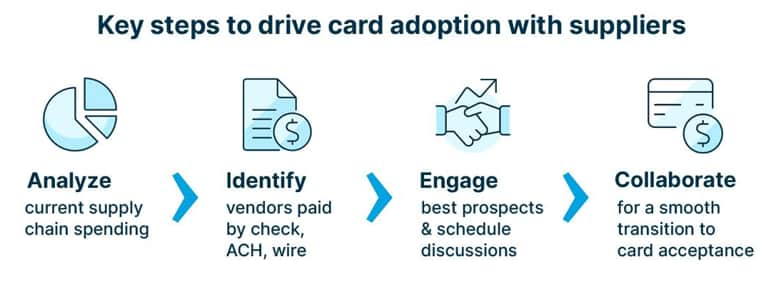- Centralizing procurement around a robust commercial card program for vendor payment processing can dramatically increase efficiency for your teams and your suppliers.
- Using virtual cards for supplier payments enables procurement teams to derisk payments and save time with automated expense reporting.
- Understanding how to address vendor concerns can help staff engage supply chain partners and overcome vendor resistance to drive adoption of card payments.
Most companies look for ways to cut costs, while boosting efficiency. One of the smartest strategies is to centralize your procure-to-pay process around a commercial card program with integrated and automated spend management capabilities. It simplifies workflows for your business and your supply chain partners. But you may need to convince some vendors to accept commercial cards, if you’ve typically paid them via ACH or check.
That may sound like a task for your finance team. Yet, your procurement experts are often the ideal people to negotiate for card acceptance as part of strengthening supplier relationships. You can help them understand how they will benefit and how to overcome resistance with vendors.
Key benefits of using commercial cards for supplier payments
In fast-growth companies, employees may be in a rush for supplies or making travel plans. They may not know which vendors are approved, or not want to wait weeks for a company card. So, they pay using their own cards and get reimbursed or submit invoices to the finance team that get paid by various methods. This fragmented approach to procurement makes it more complicated to track and report expenses.
Centralizing spend, around a robust commercial card program can make life easier for everybody. How can you start turning the tide and reap the benefits of procurement automation?
Identify opportunities for procure-to-pay with commercial cards
- Analyze supplier payments across payment types to identify vendors paid by ACH, check, or wire that could be paid on your commercial card. Flip these vendors over to card payment to start earning rewards/revenue.
- Use card data to identify top spending patterns, such as most-used expense categories and seasonal trends. You can leverage this data in supplier negotiations. For suppliers that you pay by ACH or check, consider engaging them to accept cards as a pathway to win more of your business.
Boost efficiency with procurement process automation
Optimizing your card program for supplier payments can expedite procurement processes to save time and keep teams focused on important work. For example:
- Instantly enable employees with virtual cards you can customize with pre-set budgets, vendor categories and expense codes, pre-approvals and more. Procurement teams can easily meet urgent needs or stock up to avoid risk if supply chain disruptions seem likely.
- Automate expense reporting so staff can submit expenses and receipts via web or mobile as spend occurs. No more time-intensive manual reporting. And preset expense codes on virtual cards ensure purchases are tracked correctly to the general ledger, expediting month-end close.
- Simplify business travel by providing virtual cards and travel booking integrated with your spend management platform. Your people avoid having to spend on their own and wait for reimbursement, while automated policies ensure they use approved travel vendors and adhere to budgets. There’s also no need for manual expense reports. Travel purchases paid through the platform automatically reconcile in your system for easier accounting.

Tips to overcome vendor resistance for card acceptance
Once you’ve rallied teams around optimizing procure-to-pay processes, they are better equipped to convince suppliers to accept your commercial card. It helps if you can anticipate and address some common points of resistance, for example:
- Offset concern about card processing fees – Paying interchange fees can cut into profits, and vendors may not be able to embed that cost into their pricing. As an incentive, you might offer shorter payment terms or even pre-payment with your commercial card. Getting paid sooner, particularly for large invoices, boosts a supplier’s working capital to better support their operations.
- Avoid complex reconciliation with better data – Traditional card payments have limited remittance data, so vendors may think it adds more time and manual work to reconcile invoices. Emphasize how your virtual card payments dramatically increase efficiency. You can embed data such as purchase order or invoice number, product SKU and other notes. You can even onboard companies into a preferred vendor enablement program to automate payments and reconciliation directly to their systems.
- Enhance efficiency without disrupting check-based workflows – For suppliers with established systems and processes to receive and reconcile checks, accepting card payments could seem like a hassle. Reinforce that card acceptance gives them cash flow in a day or two, instead of waiting weeks for checks to arrive and clear. And virtual cards can include all invoice details already digitized, making reconciliation faster and more accurate than manual check handling.
Turn supplier payments into a win-win for your business and vendor payment processing
Using your commercial card to streamline procurement processes is an obvious win for your internal teams. To get your vendors on board as well, help them see the shift as an upgrade not a disruption. Accepting cards for supplier payments can give them faster access to cash flow and save time with more efficient and accurate reconciliation. And best of all, they may benefit from becoming your supplier of choice.
Learn how SVB commercial cards and AI-powered spend management can enable cost-efficient procurement to help your business fuel growth.










